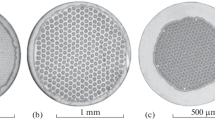Abstract
The crystal growth of Nb3Sn by the bronze method has been investigated by using diffusion couples consisting of niobium and bronze with the addition of third elements. When the specimens were annealed at temperatures between 973 and 1073 K, the time-dependence of layer thickness was represented approximately by the function ofd=kt m. The time exponent changed from 1/3 to unity depending on the annealing condition as well as on the nature of the third element. By the addition of titanium, hafnium, zirconium, indium and galium to the bronze, the growth rate of the compound layer increases. Faster layer growth corresponds to a larger time exponent. The following three processes are suggested to be important for controlling layer growth: diffusivity of tin atoms through grain boundaries in the compound layer, diffusivity of tin atoms through the matrix of the compound, and the rate of the chemical reaction to form the compound. Essentially these combined processes control the overall rate of layer growth. The grain size is found to be the most effective structural parameter to affect directly the maximum global pinning force. The critical current at a magnetic field of 5T can be scaled by both the layer thickness and the inverse grain size.
Similar content being viewed by others
References
M. Suenega, in “Superconducting Materials Science, Metallurgy, Fabrication and Applications”, edited by S. Foner and B. B. Schwartz (Plenum, New York, 1981) p. 201.
H. H. Farrell, G. H. Gilmer andM. Suenaga,J. Appl. Phys. 45 (1974) 4025.
D. Dew-Hughes, T. S. Luhman andM. Suenaga,Nucl. Technol. 29 (1976) 268.
B. V. Reddi, S. Ray, V. Raghavan andA. V. Marlikar,Phil. Mag. 38A (1978) 559.
J. D. Livingston,IEEE Trans. Magn. 14 (1978) 611.
M. Suenaga, W. B. Sampson andT. S. Luhman,ibid. 17 (1981) 646.
K. Tachikawa, T. Asano andT. Takeuchi,Appl. Phys. Lett. 39 (1981) 766.
K. Tachikawa, H. Sekine andY. Iijima,J. Appl. Phys. 53 (1982) 5534.
T. Luhman, in “Metallurgy of Superconducting Materials”, edited by T. Luhman and D. Dew-Hughes (Academic Press, New York, 1979) p. 221.
S. K. Agarwal, S. B. Samanta, V. K. Batra andA. V. Narlikar,J. Mater. Sci. 19 (1984) 2057.
H. Wada, M. Kimura andK. Tachikawa,ibid. 13 (1978) 1943.
S. Ochiai, K. Osamura andT. Uehara,J. Mater. Sci. 21 (1986) 1020.
J. Crank, in “Mathematics of Diffusion” (Oxford University Press, 1957) p. 26.
H. Oikawa andA. Hosoi,Scripta Metall. 9 (1975) 823.
J. Szekely, J. W. Evans andH. Y. Sohn, in “Gas-Solid Reactions” (Academic Press, New York, 1976) p. 65.
E. T. Turkdogan, in “Physical Chemistry of High Temperature Technology” (Academic Press, New York, 1980) p. 258.
G. N. Ronami, V. I. Gryzunov, I. A. Baranov, N. T. Konovalov, V. I. Sokolov andN. S. Vorobeva,Izv. Akad. Nauk SSSR Neorg. Mater. 7 (1971) 1490.
W. Schauer andW. Schelb,IEEE Trans. Magn. MAG-17 (1981) 374.
R. M. Scanlan, W. A. Fietz andE. F. Koch,J. Appl. Phys. 46 (1975) 2244.
B. J. Shaw,ibid. 47 (1976) 2146.
J. D. Livingston,Phys. Stat. Solids (a)44 (1977) 295.
M. Suenaga, K. Tsuchiya, N. Higuchi andK. Tachikawa,Cryogenics 25 (1985) 123.
Author information
Authors and Affiliations
Rights and permissions
About this article
Cite this article
Osamura, K., Ochiai, S., Kondo, S. et al. Influence of third elements on growth of Nb3Sn compounds and on global pinning force. J Mater Sci 21, 1509–1516 (1986). https://doi.org/10.1007/BF01114703
Received:
Accepted:
Issue Date:
DOI: https://doi.org/10.1007/BF01114703




